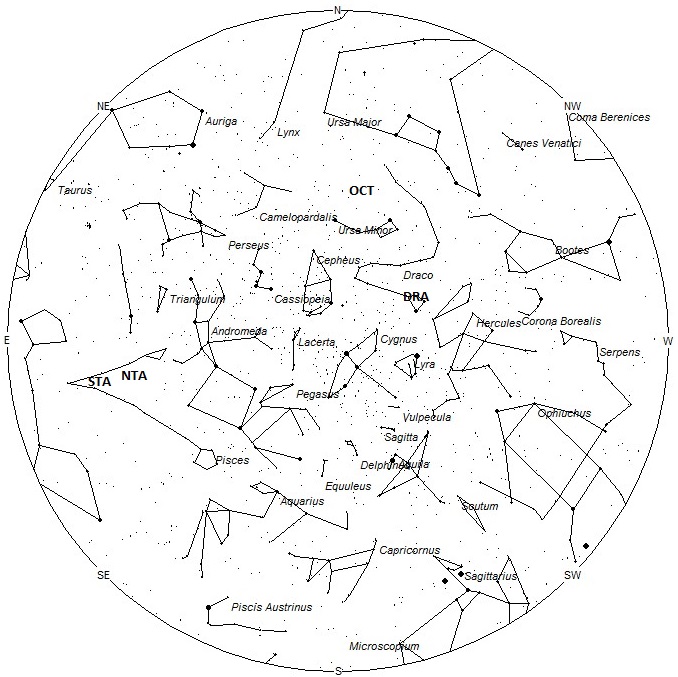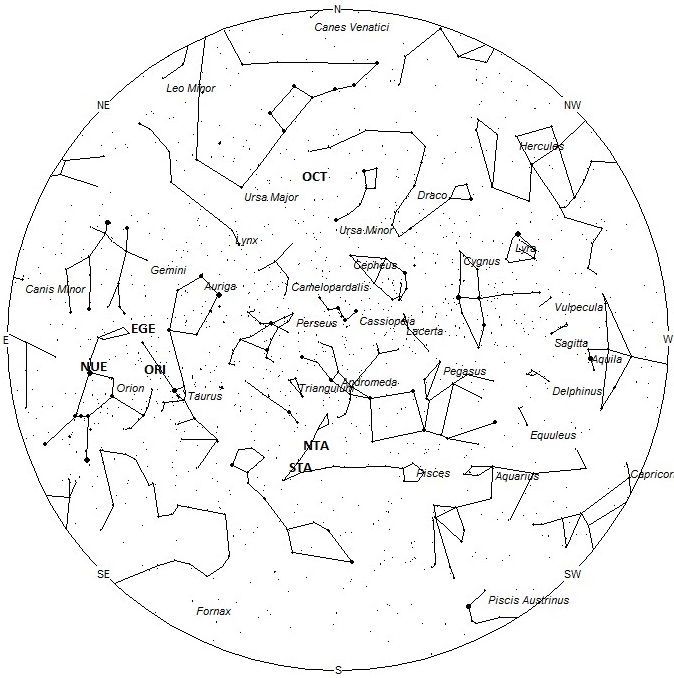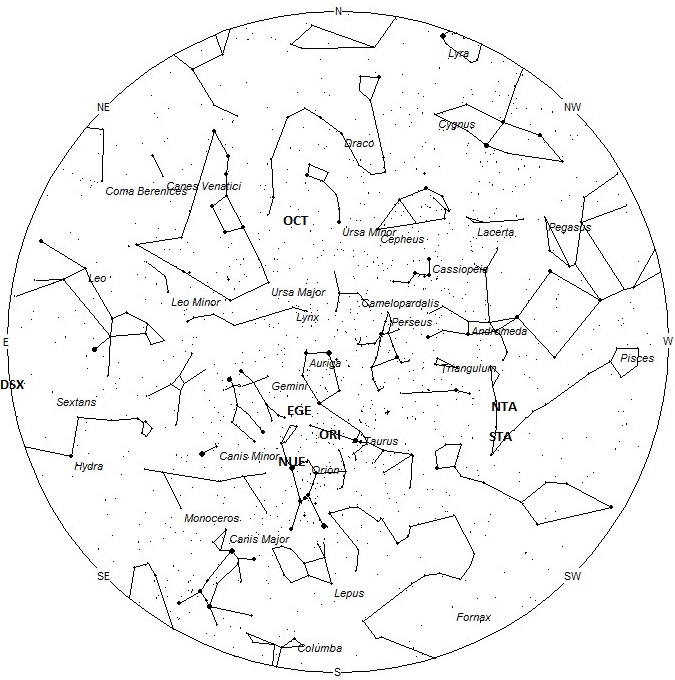During this period the moon reaches its first quarter phase on Saturday October 5th. At this time the moon will be located 90 degrees east of the sun and will set near 23:00 local summer time (LST). As the week progresses the window of dark skies during the morning hours will decrease with each passing night. The estimated total hourly meteor rates for evening observers this week is near 4 for those viewing from the northern hemisphere and 3 for those located south of the equator. For morning observers the estimated total hourly rates should be near 21 as seen from mid-northern latitudes (45N) and 15 as seen from tropical southern locations (25S) . The actual rates will also depend on factors such as personal light and motion perception, local weather conditions, alertness and experience in watching meteor activity. Evening rates are reduced during this period due to moonlight. Note that the hourly rates listed below are estimates as viewed from dark sky sites away from urban light sources. Observers viewing from urban areas will see less activity as only the brightest meteors will be visible from such locations.
The radiant (the area of the sky where meteors appear to shoot from) positions and rates listed below are exact for Saturday night/Sunday morning October 5/6. These positions do not change greatly day to day so the listed coordinates may be used during this entire period. Most star atlases (available at science stores and planetariums) will provide maps with grid lines of the celestial coordinates so that you may find out exactly where these positions are located in the sky. A planisphere or computer planetarium program is also useful in showing the sky at any time of night on any date of the year. Activity from each radiant is best seen when it is positioned highest in the sky, either due north or south along the meridian, depending on your latitude. It must be remembered that meteor activity is rarely seen at the radiant position. Rather they shoot outwards from the radiant so it is best to center your field of view so that the radiant lies at the edge and not the center. Viewing there will allow you to easily trace the path of each meteor back to the radiant (if it is a shower member) or in another direction if it is a sporadic. Meteor activity is not seen from radiants that are located below the horizon. The positions below are listed in a west to east manner in order of right ascension (celestial longitude). The positions listed first are located further west therefore are accessible earlier in the night while those listed further down the list rise later in the night.
These sources of meteoric activity are expected to be active this week.
.
The Draconids (DRA) are expected to be active on October 8/9 this year. Last year produced a nice outburst but no substantial activity is expected in 2019. The radiant lies at 17:32 (263) +56. This position lies in southeastern Draco, very close to the position occupied by the faint star known as Kuma (nu Draconis). With an entry velocity of 21 km/sec., the average Draconid meteor would be of very slow velocity. These meteors are poorly seen from the southern hemisphere due to the low radiant altitude seen from below the equator.
We are now encountering inbound debris from comet 2P/Encke, which has a radiant superimposed upon the anthelion radiant. Since it has been shown that meteors from 2P/Encke are more numerous we will recognize this activity as the Taurids. There are two distinct radiants for the Taurids. The activity profile for the Southern Taurids is unusual in that there are several indistinct peaks throughout the activity period. The difference between the peaks and valleys of activity is not great, but definitely noticeable in video data. These peaks occur near October 10, October 29 through November 3, and near November 15th. After this last peak activity slowly wanes and eventually disappears by Christmas. The Northern branch reaches maximum near November 3rd and remains in a plateau-like peak for about 10 days. After November 12th activity slowly wanes and disappears about a week before Christmas. See the charts and table below for positions of these radiants.
The Orionids (ORI) are active from a radiant located at 05:18 (079) +17. This area of the sky lies in eastern Taurus, 5 degrees southwest of the 3rd magnitude star known as Tianguan (zeta Tauri). The radiant is best placed near 0600 LST, when it lies highest above the horizon. Current hourly rates would be near 3 per as seen from the northern hemisphere and 2 as seen from south of the equator. With an entry velocity of 67 km/sec., most activity from this radiant would be of swift speed.
The epsilon Geminids (EGE) are active from September 30 through October 25 with maximum activity occurring on October 11. The radiant is currently located at 05:53 (088) +28, which places it in northeastern Taurus 5 degrees east of the 2nd magnitude star known as El Nath (beta Tauri). This area of the sky is best placed in the sky during the last hour before dawn, when it lies highest above the horizon in a dark sky. Current rates would be near 2 per hour as seen from the northern hemisphere and near 1 as seen from southern of the equator. With an entry velocity of 70 km/sec., most activity from this radiant would be of swift speed.
The nu Eridanids (NUE) were co-discovered by Japanese observers using SonotoCo and Juergen Rendtel and Sirko Molau of the IMO. Activity from this long-period stream stretches from August 24 all the way to November 16. Maximum activity occurred on September 24th. The radiant currently lies at 05:54 (089) +09, which places it in northern Orion, 1 degree north of the 1st magnitude star known as Betelgeuse (alpha Orionis). This area of the sky is best seen during the last dark hour before dawn when the radiant lies highest in a dark sky. Current rates are expected to be near 1 per hour during this period no matter your location. With an entry velocity of 67 km/sec., the average meteor from this source would be of swift velocity.
The Daytime Sextantids (DSX) are not well known due to the fact that the radiant lies close to the sun and these meteors are only visible during the last couple of hours before dawn. The radiant is currently located at 10:42 (161) -04. This position lies in central Sextans, 7 degrees southeast of the 4th magnitude star known as alpha Sextantis. This area of the sky is best placed in the sky during the last hour before dawn, when it lies highest above the horizon in a dark sky. Current rates would be most likely less than 1 per hour no matter your location. Spotting any of this activity would be a notable accomplishment. With an entry velocity of 33km/sec., most activity from this radiant would be of medium-slow speed.
The October Camelopardalids (OCT) are a recent discovery due to an outburst recorded by video cameras in 2005. Activity has occurred every year since and visual observers should be able to detect these meteors. This source is active from October 5-9 with maximum falling on the 6th. The radiant position lies near 11:13 (167) +78. This area of the sky is located in a barren area of extreme northeastern Camelopardalis. The easiest way to pinpoint the radiant is to extend a line eastward from the bottom two stars of the “bowl of the Little Dipper”. Extend another line northward from the “pointers” of the Big Dipper. Where these lines intersect is the location of the radiant. This area of the sky is above the horizon all night long but is best seen during the last dark hour before dawn when the radiant lies highest in a dark sky. Rates are expected to be low except near maximum activity. Due to the location near the northern pole, these meteors are not visible from the southern hemisphere. With an entry velocity of 47 km/sec., the average meteor from this source would be of medium velocity.
As seen from the tropical southern latitudes (25S), one would expect to see approximately 7 sporadic meteors per hour during the last hour before dawn as seen from rural observing sites. Evening rates would be near 2 per hour. As seen from mid-northern hemisphere (45N), morning rates would be near 10 per hour as seen from rural observing sites and 3 per hour during the evening hours. Locations between these two extremes would see activity between the listed figures. Evening rates are reduced during this period due to moonlight.
The list below offers the information from above in tabular form. Rates and positions are exact for Saturday night/Sunday morning except where noted in the shower descriptions.
| SHOWER | DATE OF MAXIMUM ACTIVITY | CELESTIAL POSITION | ENTRY VELOCITY | CULMINATION | HOURLY RATE | CLASS |
| RA (RA in Deg.) DEC | Km/Sec | Local Summer Time | North-South | |||
| Draconids (DRA) | Oct 09 | 17:32 (263) +56 | 21 | 18:00 | <1 – <1 | II |
| Northern Taurids (NTA) | Nov 03 | 01:24 (021) +14 | 28 | 02:00 | 2 – 1 | II |
| Southern Taurids (STA) | Oct 10 | 01:40 (025) +07 | 27 | 02:00 | 3 – 3 | II |
| Orionids (ORI) | Oct 22 | 05:18 (079) +17 | 67 | 05:00 | 3 – 2 | I |
| epsilon Geminids(ORI) | Oct 11 | 05:53 (088) +28 | 70 | 06:00 | 2 – 1 | II |
| nu Eridanids (NUE) | Sep 24 | 05:54 (089) +09 | 67 | 06:00 | 1 – 1 | IV |
| Daytime Sextantids (DSX) | Sep 29 | 10:42 (161) -04 | 33 | 11:00 | <1 – <1 | IV |
| October Camelopardalids (OCT) | Oct 06 | 11:13 (167) +78 | 47 | 11:00 | 1 – <1 | IV |




